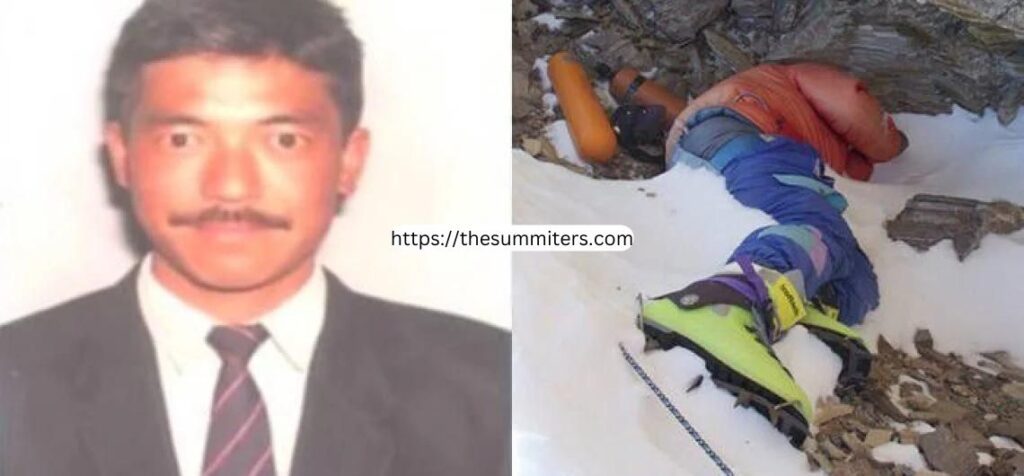
Tsewang Samanla, famously remembered as the man with the distinctive green mountaineering boots on the unforgiving slopes of Mount Everest, lived a life punctuated by dreams, determination, and an unwavering love for adventure. His story unfolds from his humble beginnings in Ladakh to the fateful events that marked his journey towards the world’s tallest peak.
Early Life and Beginnings,
Tsewang Samanla hailed from Ladakh, a region nestled among the towering peaks of the Himalayas. Growing up amidst these awe-inspiring landscapes, he forged an unbreakable bond with the mountains from an early age. Ladakh’s rugged terrains cultivated his passion for adventure while instilling in him a deep respect for the challenges that lay within those lofty peaks.
Life in Ladakh was demanding, with harsh winters and remote living conditions. However, it was precisely this environment that nurtured Tsewang’s adventurous spirit, teaching him invaluable lessons in resilience and determination.
Read More: Phasang Lhamu Sherpa Sherpas
Green Boot’s Venturing into the World of Mountaineering
Tsewang Started the journey into the world of mountaineering when he found himself epidemic drawn to the towering giants that surrounded his homeland. The Himalayas with their majestic summits and terrifying challenges, beckoned to him. With the unwavering support of his family and community, he embarked on a path that would transform him into a dedicated mountaineer.
Local mountaineers and mentors likely played a pivotal role in shaping his early training. Tsewang Samanla’s innate connection with the mountains, coupled with his steadfast determination, set him on a trajectory that would see him become a prominent figure in the world of mountaineering.
Triumphs in the Mountains
Tsewang Samanla’s mountaineering career was punctuated by noteworthy accomplishments that showcased his skills, perseverance, and unwavering passion for the sport.

Conquering Peaks in India
He began his journey by conquering several challenging peaks within India. These served as invaluable training grounds, helping him hone his skills and prepare for more daunting summits. Notably, he stood atop Stok Kangri, a prominent peak in the Stok Range of the Himalayas, at an elevation of around 6,153 meters (20,182 feet). This achievement provided him with vital high-altitude experience and a glimpse of the challenges that awaited him on even more ambitious expeditions.
Gaining International Recognition
Tsewang Samanla’s growing reputation as a skilled mountaineer quickly caught the eye of the international climbing community. He planned not only to conquer India’s peaks but also to test his abilities on the world’s highest mountains.
In the 1990s he embarked on expeditions to some of the Himalayas most terrifying peaks, including Cho Oyu and Dhaulagiri. These expeditions exposed him to the hardships of high altitude mountaineering and he showcased his courage as a climber on these demanding ascents.
The Ultimate Ascent: Everest
Yet, Tsewang Samanla’s ultimate dream was to reach the summit of the world’s highest peak, Mount Everest. His opportunity came with the historic Indo-Tibetan Border Police (ITBP) expedition, marking the first Indian attempt to ascend Everest.
The ITBP Expedition
This ambitious expedition aimed to spotlight India’s mountaineering prowess on a global stage. Tsewang Samanla was among the elite climbers chosen to represent India in this groundbreaking endeavor.
The team underwent rigorous training, both in the mountains and through specialized mountaineering programs, to prepare for the challenges of Everest. Their objective was not just to conquer the summit but also to demonstrate the skill and determination of Indian mountaineers.
The South Col Route
Tsewang Samanla’s quest to conquer Everest followed the well-established South Col route, commencing from the southern side of the mountain in Nepal. This route with its strategically positioned camps at higher elevations allowed climbers to acclimatize gradually to the thinning air.
Their journey took them from Everest Base Camp, located at an altitude of approximately 5,364 meters (17,598 feet), through the perilous Khumbu Icefall, and onward to higher camps, including Camp I, Camp II, and Camp III. All these served as crucial steps in their acclimatization process. Camp IV, known as the South Col, served as the launchpad for their summit attempt, nestled at approximately 7,920 meters (26,000 feet).
The Summit Attempt
Tsewang Samanla’s summit attempt, like those of his fellow climbers, was a meticulously planned venture. Departing from Camp IV in the early hours of their summit day, the climbers embarked on their final ascent under the cloak of night. Despite its challenges, this approach was strategic, designed to minimize their exposure to the harsh daytime conditions.
The physical and mental health are the demands of high altitude mountaineering loomed large as they ascended towards the summit. At altitudes exceeding 8,000 meters (26,247 feet), climbers grappled with altitude sickness, frostbite, exhaustion, and the formidable challenge of descending in the darkness.
The Tragic Outcome
Tsewang Samanla’s life, much like that of numerous climbers in the ill-fated 1996 Everest season, was forever altered by the formidable mountain and the unpredictable forces of nature.
That season witnessed overcrowding, communication hurdles, and an unforeseen storm converging to create one of Everest’s deadliest disasters. Tragically, eight climbers lost their lives, including experienced guides Rob Hall and Scott Fischer.
In the midst of this chaos, Tsewang Samanla faced unimaginable challenges during his summit attempt. The exact circumstances of his death remain shrouded in mystery, but his narrative forever intertwines with the 1996 Everest tragedy
The Green Boots Cave
Following the catastrophe, rescue operations were launched to save stranded climbers. Tsewang Samanla and his team, confronted with dire conditions on their descent, sought refuge in a small cave-like feature on the South Col route to escape the ferocious storm. This place, later known as the “Green Boots Cave,” would become an eerie resting place for Tsewang Samanla himself.
The cave derives its name from the distinctive green mountaineering boots worn by the unidentified climber whose lifeless body rests within. These boots have transformed into an enduring symbol of Everest’s dangers and enigmas. Nestled at an altitude of roughly 8,500 meters (27,887 feet), the cave is a brief distance below Everest’s summit.
Climbers who venture along the South Col route often encounter Tsewang Samanla’s frozen form as they pursue their ascent. His body, clad in a green down suit and preserved by the cold, serves as a haunting reminder of the mountain’s unforgiving nature.
The Ethical Quandary
Tsewang Samanla’s presence on Everest has ignited a profound debate concerning the ethics of high-altitude mountaineering and the respect owed to the deceased. Climbers who pass by the site often grapple with conflicting emotions.
Some argue that the body should remain undisturbed as a mark of respect for the fallen climber, considering it a stark reminder of the mountain’s harsh realities and the sacrifices made in pursuit of ambition.
Others, however, contend that leaving a climber exposed in such a manner is disrespectful and contravenes principles of dignity. In recent years, Tsewang Samanla’s presence has rekindled discussions about the responsibilities of climbers and the ethical considerations governing their actions on the world’s loftiest peak.
Tsewang Samanla’s life, forever immortalized through the moniker “Green Boots,” was characterized by achievements, unwavering resilience, and an indomitable spirit of adventure. From his Ladakhi upbringing to his triumphant ascent of Everest and his heart-wrenching end amidst the mountain’s unyielding embrace, his journey encapsulates the indomitable human spirit.
As climbers continue their ascents of Everest, they encounter Green Boots, a poignant symbol of human tenacity, the relentless pursuit of adventure, and the sacrifices made in the quest for the world’s highest summit. His legacy endures, beckoning mountaineers to contemplate the profound impact of their aspirations on the mountains and the broader world.